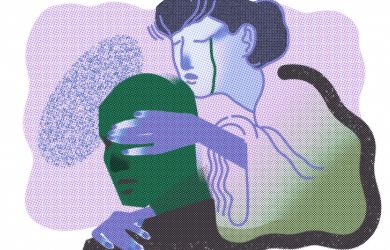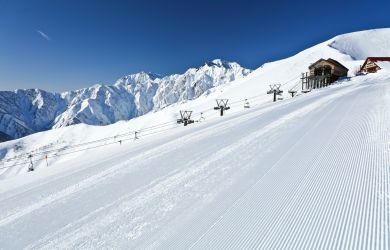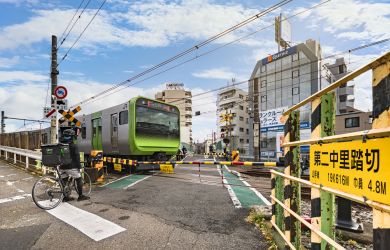
October 18, 2011
Shitamachi Rocks
Young Japanese find their muse in Tokyo’s old downtown
By Metropolis
Originally published on metropolis.co.jp on October 2011

Asakusa Jinta
Asakusa Jinta call themselves a “hard marching band,” perhaps referring to how fast they have to march with the police on their tail.
“We made a sound system using one of those old Showa-period bicycles with a sidecar,” guitarist Shinya tells Metropolis, “so when we play in the streets we can make a quick getaway.” He smiles. “There aren’t really any live venues in Asakusa and it’s prohibited to play music on the streets.”
Stand-up bassist, singer and bandleader Oshow adds: “The police might give us a caution if they catch us playing so we’ve got to keep moving. Before, we built small stages on either side of the Sumida River to make open-air festivals. The audiences threw so much money at us we could earn more than playing at a live house, but the police would always come rushing over. Asakusa Jinta’s activity is always watched by the cops.”
Oshow tells me of when he saw an old guy with the sidecar-fitted bike one day. You often see such characters in the shitamachi areas of downtown northeast Tokyo: Ueno, Asakusa and Yoshiwara. They are workers carrying lumber, masses of tin cans, tatami mats—or tofu, which they hawk from an icebox on the sidecar. In an inspired moment Oshow made an offer for the vendor’s bike.
But while Asakusa Jinta are all about downtown, the band seems to be moving in a different direction… upward.
They have played all across Europe—Britain, Holland, Finland, Sweden—and made an impressive appearance at the South by Southwest Festival. “We also played the French Embassy in Tokyo, so you could say we’ve played in France too,” says Oshow.
They say “hard marching” but basically Asakusa Jinta are an insane jamboree of styles on stage—like a military brass band tossing in elements of Coltrane, rockabilly, ska and punk. But it all melds together beautifully, like they aren’t trying, like they are being themselves—like they are enjoying themselves. And if you see a band having such fun, it infects you too.
If you like the anything-goes music of bands such as The Pogues, Gogol Bordello or Tokyo Ska Paradise Orchestra, then Asakusa Jinta are right up your street—especially if you live in Asakusa, as do most of the band members.
They are a bunch of young guys—and one girl—yet they are proud of the old-town community spirit of Asakusa. Why?
“We embrace the ancient music of Japan but are trying to develop it using new instruments,” Oshow says. “In a sense, time has stopped in Asakusa and it is our role to move it forward. Past musicians used shamisen and a drum—we use saxophone, trumpet and guitar. After the Pacific War, Japanese culture was drained and we now have to rebuild our culture and move in a positive direction while retaining elements of our traditional spirit.”
As well as Shinya on guitar, Oshow standing at the front tearing away at his stand-up bass, and MieKachint blowing furiously into her horns, the other members are B-Ken, who provides a matsuri vibe on his euphonium and tuba, Seasir on trumpet, and Kaname, low-key at the back, maintaining a steady beat on drums.
I tell them during our interview at Oshow’s small Asakusa bar, Ginmaku Rock (see opposite), that their furious energy makes it sound like there are 20 members, especially on their new album Yamiyo De Dance (Dance In The Dark). “We did have 13 members in the original Asakusa Jinta,” says Shinya. “Back then we were called Hyakke no Gyoretsu, which kind of means a bunch of Japanese monsters making a line.”
Oshow talks of chindon, disbanded World War II military bands that had to play in the streets to earn their bread, as the band’s prime influence. “‘Jinta’ means a small brass band,” he explains.
I ask Oshow how the music has developed since 2005 when they released their first, underground—and now unavailable—record, Asakusa Rock. “Before, we had a conceptual angle, but now we are getting down to the basics and concentrating on the music,” says Oshow. “We make music with the word ‘nostalgic’ in our heads and are moving in that direction.”
If The Pogues represent Ireland’s folk music, and Gogol Bordello that of the Gypsies, then Asakusa Jinta might be what you’d call the folk music of Japan—but if you’re expecting weepy enka, forget it. You’re more likely to get sweaty in a moshpit.

Tokyo Taishu Kayou Gakuden
“We long for ‘the good old days’ of Japanese culture and try to connect the young generation to older people through our music,” says Kotaro Takashima, singer of Tokyo Taishu Kayou Gakuden. It is a sunny September afternoon next to the Sumida River in Asakusa, and we are chatting during a break in one of their street shows. “The young and old are isolated from each other,” he adds, puffing on a long, thin, vintage silver pipe. “Music is a tool to solve that problem.”
Kayou Gakudan have the same basic principles as Asakusa Jinta: taking pride in Japanese history and musical heritage. But unlike the upbeat, modern style of Jinta, these guys go right back to the source, breathing fresh life into long-forgotten classics from the Taisho and Showa Periods. Kotaro’s intensely respectful vocal delivery bursts not only from his lungs, but from his heart and soul. There’s also his brother Yujiro, two years younger at 26, masterfully manipulating his accordion, and. in the background, Rei Taskatori, the eldest of the trio at 32, on stand-up bass.
They interpret kayo music—basically slow-burning Japanese pop from the ’20s to the ’50s. It’s best described as jazzed-up folk music, a bit like Frank Sinatra doing slightly sped-up enka.
The first songs they played were popular numbers like “Ginza Kan Kan Musume.” But they weren’t happy with their initial selection, “We researched the really old traditional folk songs that old people like,” Kotaro says. “Our repertoire is now at a better level.”
Kayou Gakudan invite old folks to join their street sessions. Two guys and a woman, each probably approaching 80 years old, often join in on percussion, whether it’s beating a small drum with a brush or tapping empty beer cans on an upturned plastic bucket. If you have seen the Kurosawa-inspired movie Ame Agaru and the scene at the inn where people join in singing, you might find it familiar.
Kayou Gakudan usually play in the streets of Ueno and Asakusa. “Live houses are more business-oriented,” says Kotaro. “We make our living by laying one of our hats out and playing in the parks and on the streets.”
http://chesterfield-records.com/ttkg.html

Ginmaku Rock
I am sitting on a red velvet sofa and Safi is shaking her ample breasts in my face. But she is half-decent… That’s to say, her nipples are covered by glittery tassels. I am at Asakusa Jinta leader Oshow’s Showa-style bar cum live house Ginmaku Rock in the heart of Asakusa, and it is a riot of a night. Packed with people lounging on sofas or propping up the bar, which is manned—so to speak—by a guy dressed as an oiran (Edo-Period high-class female prostitute). Safi is the main draw among a series of impressive burlesque dancers this evening, but bands also play. Oshow even invited my band to perform having never heard us—so you can guess this is a place where anything goes. It is hard to find, tucked away in a side street near Asakusa Keiba Wins, and mostly only locals go there. But if you do find it, you won’t regret it—the bartender makes some mean White Russians.
2F, 1-41-5 Asakusa. Tel: 03-5828-6969. Open daily 9pm-late. No seating or cover charge unless there is a special live show.
Writer and musician Simon Bartz resides in a small castle in Asakusa. Contact him at www.myspace.com/yojimbotokyo or www.facebook.com/simon.bartz1





